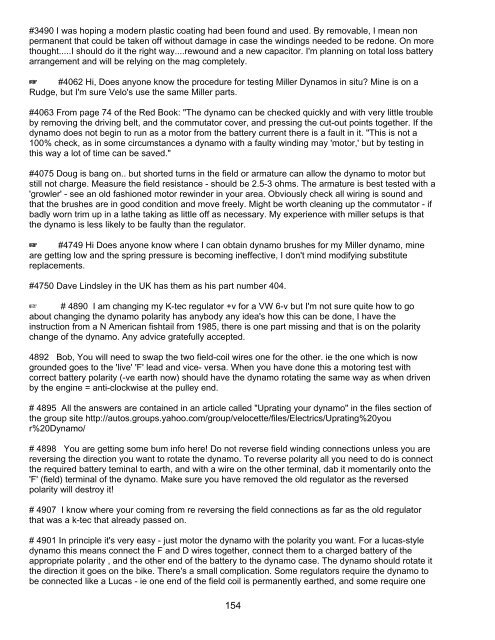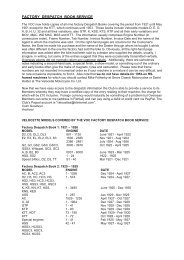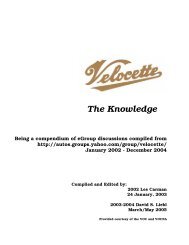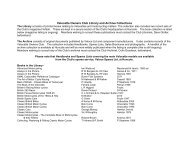The Knowledge - Velocette Owners Club
The Knowledge - Velocette Owners Club
The Knowledge - Velocette Owners Club
You also want an ePaper? Increase the reach of your titles
YUMPU automatically turns print PDFs into web optimized ePapers that Google loves.
#3490 I was hoping a modern plastic coating had been found and used. By removable, I mean non<br />
permanent that could be taken off without damage in case the windings needed to be redone. On more<br />
thought.....I should do it the right way....rewound and a new capacitor. I'm planning on total loss battery<br />
arrangement and will be relying on the mag completely.<br />
L #4062 Hi, Does anyone know the procedure for testing Miller Dynamos in situ? Mine is on a<br />
Rudge, but I'm sure Velo's use the same Miller parts.<br />
#4063 From page 74 of the Red Book: "<strong>The</strong> dynamo can be checked quickly and with very little trouble<br />
by removing the driving belt, and the commutator cover, and pressing the cut-out points together. If the<br />
dynamo does not begin to run as a motor from the battery current there is a fault in it. "This is not a<br />
100% check, as in some circumstances a dynamo with a faulty winding may 'motor,' but by testing in<br />
this way a lot of time can be saved."<br />
#4075 Doug is bang on.. but shorted turns in the field or armature can allow the dynamo to motor but<br />
still not charge. Measure the field resistance - should be 2.5-3 ohms. <strong>The</strong> armature is best tested with a<br />
'growler' - see an old fashioned motor rewinder in your area. Obviously check all wiring is sound and<br />
that the brushes are in good condition and move freely. Might be worth cleaning up the commutator - if<br />
badly worn trim up in a lathe taking as little off as necessary. My experience with miller setups is that<br />
the dynamo is less likely to be faulty than the regulator.<br />
L #4749 Hi Does anyone know where I can obtain dynamo brushes for my Miller dynamo, mine<br />
are getting low and the spring pressure is becoming ineffective, I don't mind modifying substitute<br />
replacements.<br />
#4750 Dave Lindsley in the UK has them as his part number 404.<br />
L # 4890 I am changing my K-tec regulator +v for a VW 6-v but I'm not sure quite how to go<br />
about changing the dynamo polarity has anybody any idea's how this can be done, I have the<br />
instruction from a N American fishtail from 1985, there is one part missing and that is on the polarity<br />
change of the dynamo. Any advice gratefully accepted.<br />
4892 Bob, You will need to swap the two field-coil wires one for the other. ie the one which is now<br />
grounded goes to the 'live' 'F' lead and vice- versa. When you have done this a motoring test with<br />
correct battery polarity (-ve earth now) should have the dynamo rotating the same way as when driven<br />
by the engine = anti-clockwise at the pulley end.<br />
# 4895 All the answers are contained in an article called "Uprating your dynamo" in the files section of<br />
the group site http://autos.groups.yahoo.com/group/velocette/files/Electrics/Uprating%20you<br />
r%20Dynamo/<br />
# 4898 You are getting some bum info here! Do not reverse field winding connections unless you are<br />
reversing the direction you want to rotate the dynamo. To reverse polarity all you need to do is connect<br />
the required battery teminal to earth, and with a wire on the other terminal, dab it momentarily onto the<br />
'F' (field) terminal of the dynamo. Make sure you have removed the old regulator as the reversed<br />
polarity will destroy it!<br />
# 4907 I know where your coming from re reversing the field connections as far as the old regulator<br />
that was a k-tec that already passed on.<br />
# 4901 In principle it's very easy - just motor the dynamo with the polarity you want. For a lucas-style<br />
dynamo this means connect the F and D wires together, connect them to a charged battery of the<br />
appropriate polarity , and the other end of the battery to the dynamo case. <strong>The</strong> dynamo should rotate it<br />
the direction it goes on the bike. <strong>The</strong>re's a small complication. Some regulators require the dynamo to<br />
be connected like a Lucas - ie one end of the field coil is permanently earthed, and some require one<br />
154





